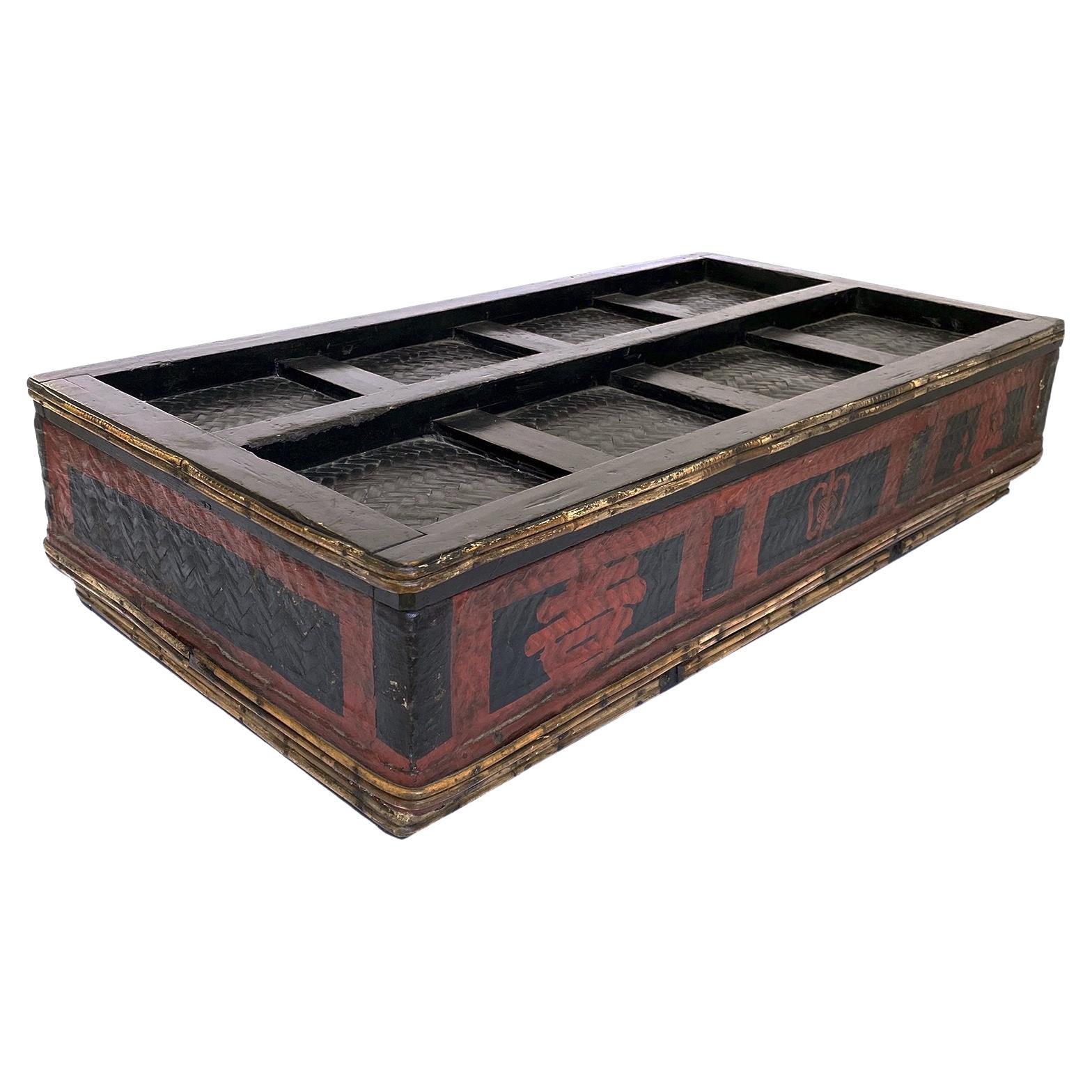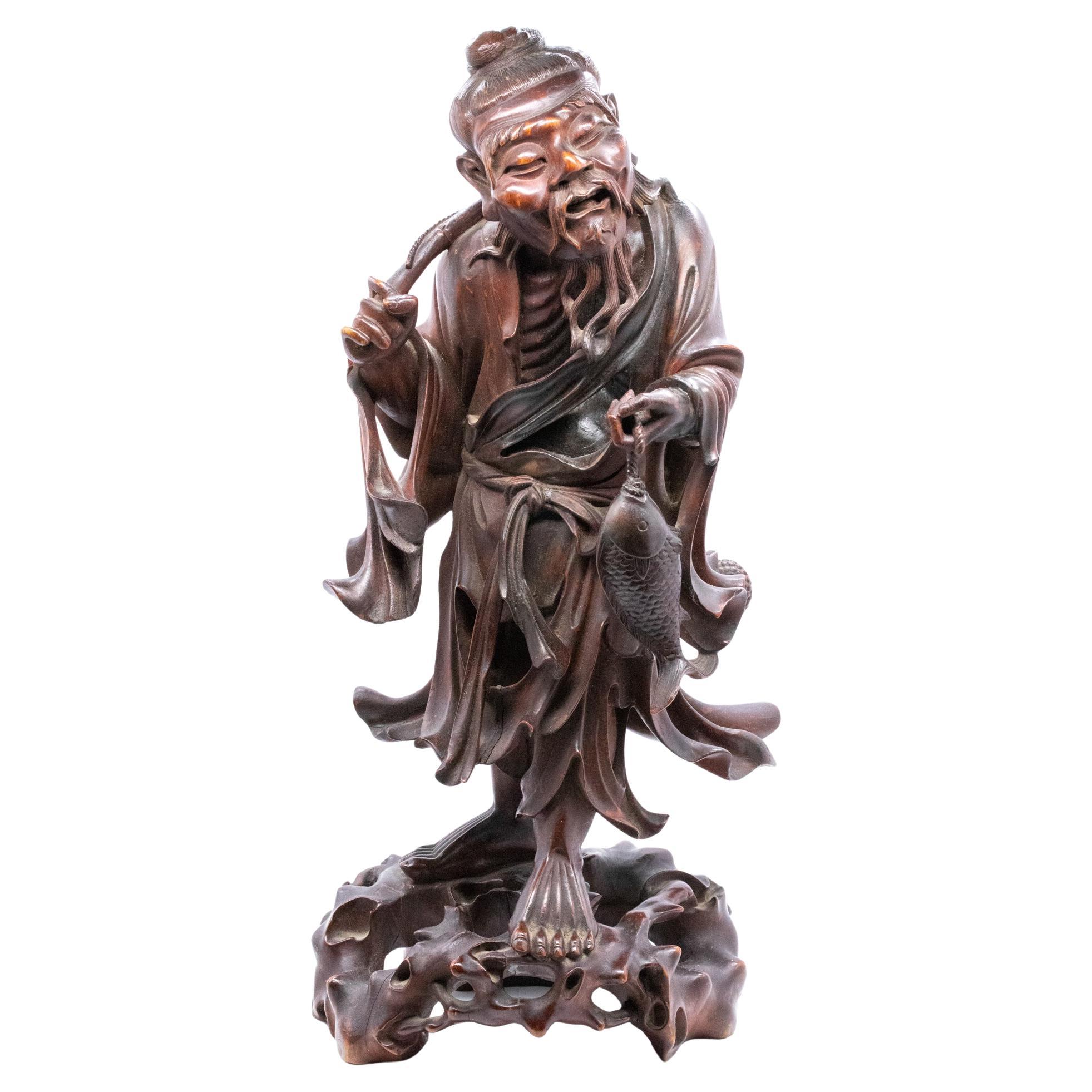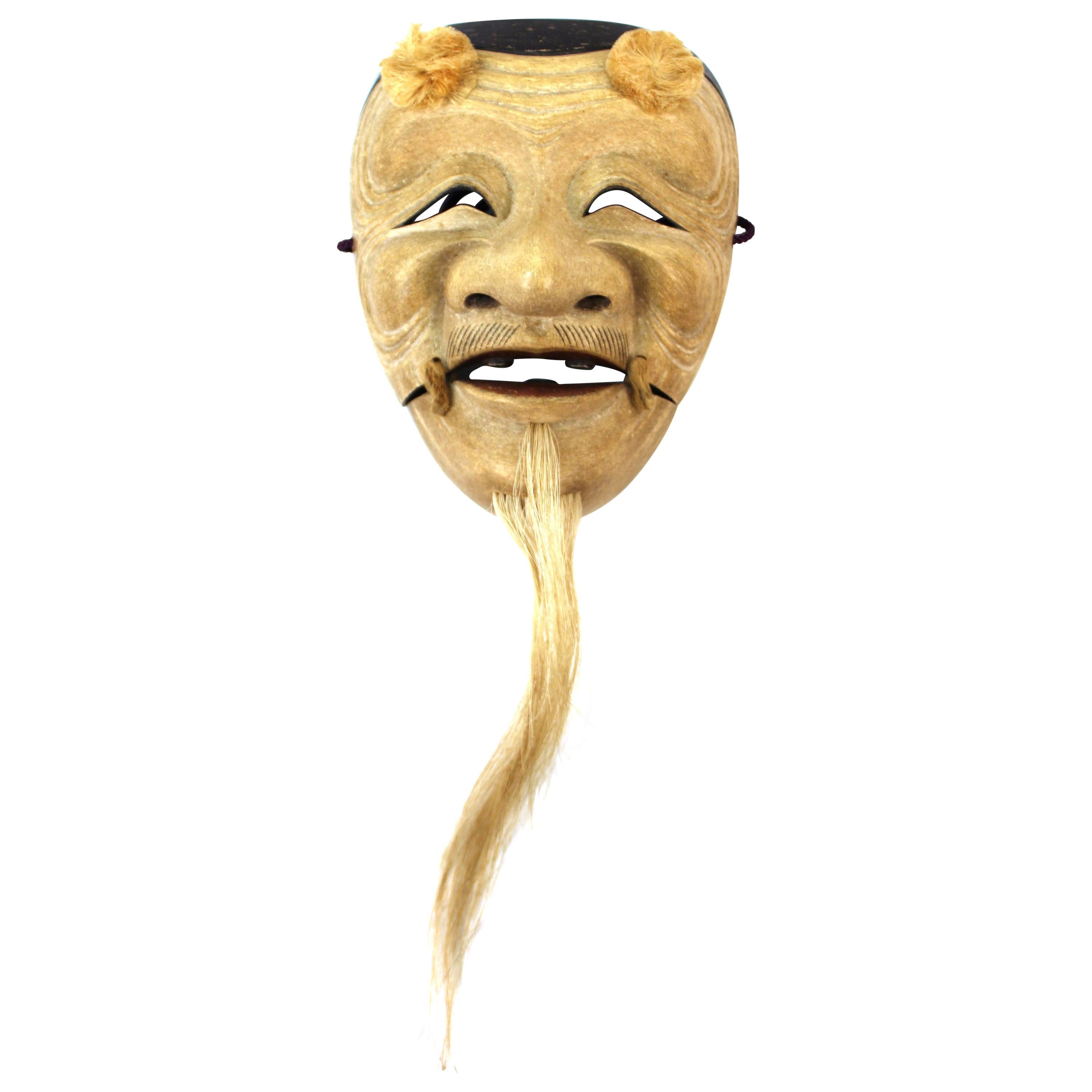Items Similar to Tenjin-Sama, Wood, Japanese Shinto Deity of Learning and Wisdom, Meiji Period
Want more images or videos?
Request additional images or videos from the seller
1 of 10
Tenjin-Sama, Wood, Japanese Shinto Deity of Learning and Wisdom, Meiji Period
About the Item
Tenjin-Sama, Shinto Deity of Learning and Wisdom, Meiji Period
Tenjin,-Sama, Deification of Sugawara no Michizane, was a famous scholar, poet and politician of the Heian period. In Japanese Shinto religion, Tenjin is the Deity of Learning and Wisdom. Sculpted in wood and painted in black and gold. Sitting on a wood stand. Meiji Period.
Note: The dimensions listed are of the statue only; the stand measures 16"D x 24"W x 17"H.
- Dimensions:Height: 17 in (43.18 cm)Width: 25 in (63.5 cm)Depth: 14 in (35.56 cm)
- Style:Meiji (Of the Period)
- Materials and Techniques:Wood,Polychromed
- Place of Origin:
- Period:
- Date of Manufacture:19th century
- Condition:Wear consistent with age and use. Minor losses. Some small loss of paint, otherwise in good shape. Stand is included but not attached.
- Seller Location:Point Richmond, CA
- Reference Number:
About the Seller
4.9
Platinum Seller
These expertly vetted sellers are 1stDibs' most experienced sellers and are rated highest by our customers.
Established in 1999
1stDibs seller since 2015
604 sales on 1stDibs
Typical response time: 2 hours
- ShippingRetrieving quote...Ships From: Point Richmond, CA
- Return PolicyA return for this item may be initiated within 3 days of delivery.
More From This SellerView All
- Meiji Period Red and Black Painted Kimono Storage Box, JapanLocated in Point Richmond, CAJapanese Kimono storage box, constructed of wood and bamboo, painted black with family crest painted in red on the sides. The top has wood slats, which ...Category
20th Century Japanese Meiji Sculptures and Carvings
MaterialsWood
- Carved Wood Ainu Bear with Baby and Fish, Hokkaido, Japan, Keyaki, Showa PeriodLocated in Point Richmond, CAAinu Bear with baby and fish, Hokkaido, Japan, Keyaki, Showa period. Hewn from one solid piece of Keyaki wood, this bear flashes a ferocious expression or...Category
20th Century Japanese Showa Sculptures and Carvings
MaterialsWood
- Japanese Lion Gion Festival Dance Mask, Lacquered Wood, Late Edo periodLocated in Point Richmond, CAJapanese Lion Gion Festival Dance Mask, Lacquered wood, Late Edo period This lion mask can be found at the head of a float in the Gion festival. It is...Category
Antique 19th Century Japanese Edo Sculptures and Carvings
MaterialsWood
- Large Wood Carved Otafuku, Goddess of Mirth, Japanese, Early 20th CenturyLocated in Point Richmond, CALarge wood carved Otafuku , Goddess of Mirth, Japanese, 20th Century. Sometimes known as Okame, a beloved and popular symbol in Japanese culture. With plump cheeks and joyful smile...Category
Early 20th Century Japanese Other Sculptures and Carvings
MaterialsWood
- Saki-Ori Farmers Coat, Northern Japan, Meiji PeriodLocated in Point Richmond, CASaki-ori farmers coat, Northern Japan, Meiji period A very heavy and substantial saki-ori coat, made of cotton with an indigo kasuri lapel. Several patches of hand sewn stitching ...Category
20th Century Japanese Meiji Textiles
MaterialsCotton
- Antique Japanese Medicine "Kanban" 'Shop Sign', Late Meiji PeriodLocated in Point Richmond, CAAntique Japanese Medicine "Kanban" (Shop Sign) with mirror, Meiji Period. The Medicine being advertised is a soothing cream used to relieve itchin...Category
Early 20th Century Japanese Meiji Paintings and Screens
MaterialsWood, Lacquer
You May Also Like
- Japan 1890 Meiji Period Ebisu Sculpture in Wood Carving of an Old FishermanLocated in Miami, FLAn extremely well detailed wood carving of Ebisu, as a fisherman. Beautiful and well detailed sculpture, created in Japan during the Meiji dynastic period (1868-1912) back in the 1890's. This piece represent the god of good fortune Ebisu. Was exceptionally carved and executed from one solid single piece of rose wood, showing a gorgeous face expression, with intricate details in the hands and feets, he's carrying as usual a rod and a fish. Ebisu (yebisu), ???, god of fortune, the ocean and fisherman. In the japanese mythology is one of the seven gods of luck, sichi-fuku-jin, the patron of the fisherman and tradesmen. he is depicted as a bearded, smiling fisherman with formal long court ropes, often carrying a rod in one hand and a tai, symbolic fish of the good luck, in the other. The height is 14.25 inches (36.20 cm) and the base measurements is 6.5 by 6.45 inches (16.5 x 16.38 cm). Meiji period, is an era of Japanese history that extended from October 23, 1868 to July 30, 1912.The Meiji era was the first half of the Empire of Japan, when the Japanese people moved from being an isolated feudal society at risk of colonization by Western powers to the new paradigm of a modern, industrialized nation state and emergent great power, influenced by Western scientific, technological, philosophical, political, legal, and aesthetic ideas. As a result of such wholesale adoption of radically different ideas, the changes to Japan were profound, and affected its social structure, internal politics, economy, military, and foreign...Category
Antique 1890s Japanese Meiji Sculptures and Carvings
MaterialsWood
- Two Rare Japanese Izumo Clay Dolls of Emperor and Tenjin, Meiji PeriodLocated in Ottawa, OntarioTwo rare Japanese Izumo clay dolls of Emperor and Tenjin, Nara Prefecture, Meiji period. Material and simple execution impart a flavor of antiquity and great decorative power. Empero...Category
Antique Late 19th Century Japanese Meiji Sculptures and Carvings
MaterialsClay
- Japan 1890 Meiji Period Signed Assembling of Okimono with a Group of SkeletonsLocated in Miami, FLA signed Okimono from the Japanese Meiji period (1868-1912). Very rare, unusual and large sculptural assembling of a dysplaying piece of okimono. Created in Japan during the imperial period of the Meiji (1868-1912). This extraordinary piece okimono sculpture depict a group of four intricately and realistically rendered carousing males skeletons representations (Gaikotsu) standing in several position. One skeleton is crouched down playing with mouses in the floor. The second is seated resting in the other's back, peacefully smoking opium. The others two are fully standing in interacting position. The entire composition is arranged freely displayed on the wood base including a woven basket, apparently with food and four playfull mouses. There are an extra five mouses in different positions, freely playing around, all of them with the eyes accented with carved black ebony. The composition is displayed on a four-legged free form carved wood platform with an inlaid red plaque engraved with the artist's signature. The level of detail and the quality of the carving is truly exceptional. Has an exact measurements of 216.15 mm by 139.7 mm by 359.41 mm (8.51 x 5.5 x 14.15 Inches). After an extensive collection of data, comparables and references to this piece, we have only been able to find only three okimono sculptures like this, with similar themes and the same quality of work. References Note: A similar carving of four skeletons playing an animated game of dominos, signed Shutaro in an inlaid rectangular red plaque, was sold in London by Christie’s South Kensington in October 14 2014, Lot 120 Sale 5546. References Note: A similar carving with four skeletons in an otherwise typical victorian scene of a photographer and three sitters signed Shutaro in an inlaid rectangular red plaque, was sold in Edinburgh at Lyon & Turnbull in November 7, 2018. References Note: A similar carving with five skeletons seated, playing cards and drinking, was sold in London by John Nicholson Fine Art on September 26, 2018. Meiji period, is an era of Japanese history that extended from October 23, 1868 to July 30, 1912.The Meiji era was the first half of the Empire of Japan, when the Japanese people moved from being an isolated feudal society at risk of colonization by Western powers to the new paradigm of a modern, industrialized nation state and emergent great power, influenced by Western scientific, technological, philosophical, political, legal, and aesthetic ideas. As a result of such wholesale adoption of radically different ideas, the changes to Japan were profound, and affected its social structure, internal politics, economy, military, and foreign relations. The period corresponded to the reign of Emperor Meiji. It was preceded by the Keio era and was succeeded by the Taisho era, upon the accession of Emperor Taisho. Okimono, is a Japanese term meaning for display an ornament; art object; or decorative object, usually displayed in a tokonoma or butsudan "Buddhist altar". It is an ornament or figure, especially one placed in a guest room. An okimono may be a small Japanese carving...Category
Antique 1890s Japanese Meiji Sculptures and Carvings
MaterialsWood
- Japanese Meiji Noh Mask in Carved WoodLocated in New York, NYJapanese early Meiji period Noh theater mask made of carved wood with gofun layers. The piece was made in Japan in circa 1880 and is signed on the back. In great antique condition wi...Category
Antique 1880s Japanese Meiji Sculptures and Carvings
MaterialsWood
- Japanese Meiji Noh Mask of OkinaLocated in New York, NYJapanese carved wood Noh mask depicting Okina. The piece was made during the late Edo - early Meiji period in the 19th century. The mask is of an older man wi...Category
Antique 19th Century Japanese Meiji Sculptures and Carvings
MaterialsWood
- Antique Japanese Meiji Period Kneeling Samurai Warrior, Circa 1870-1880Located in Savannah, GAAntique Japanese Kneeling Samurai Warrior, Circa 1870-1880. Japanese Meiji period samurai with detailed presentation of robes and helmet.Category
Antique 19th Century Japanese Meiji Sculptures and Carvings
MaterialsFabric
Recently Viewed
View AllMore Ways To Browse
Asian Pair Figurines
Chinese Rice Lamp
Chinese Light Box
Cambodian Artifacts
Granite Buddha Head
Bhumisparsha Buddha
Buddha Five
Japanese Buddha Miniature
Japanese Cat Carving
Jadeite Jade Statue
Antique Water Art
Rabbit Netsuke Ojime
Chinese Carved Coral Group
Pig Netsuke
Hina Matsuri
Cinnabar Dog
Koi Fish Statue
Tall Cast Iron Candle Sticks





